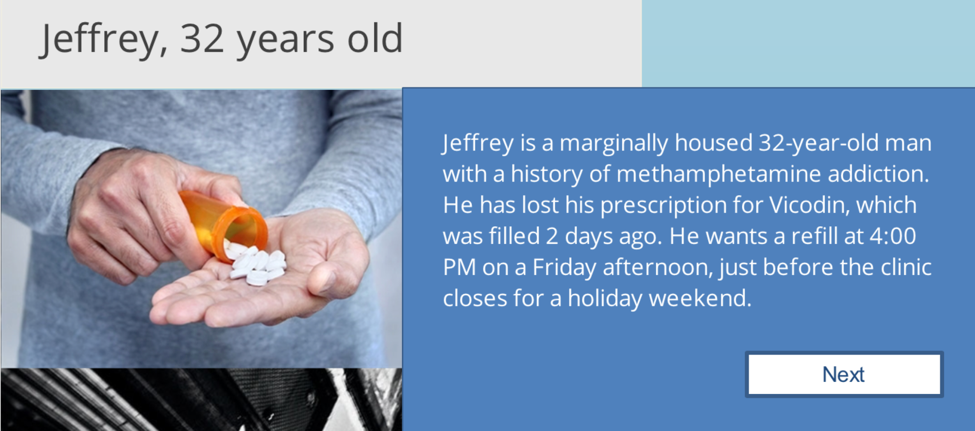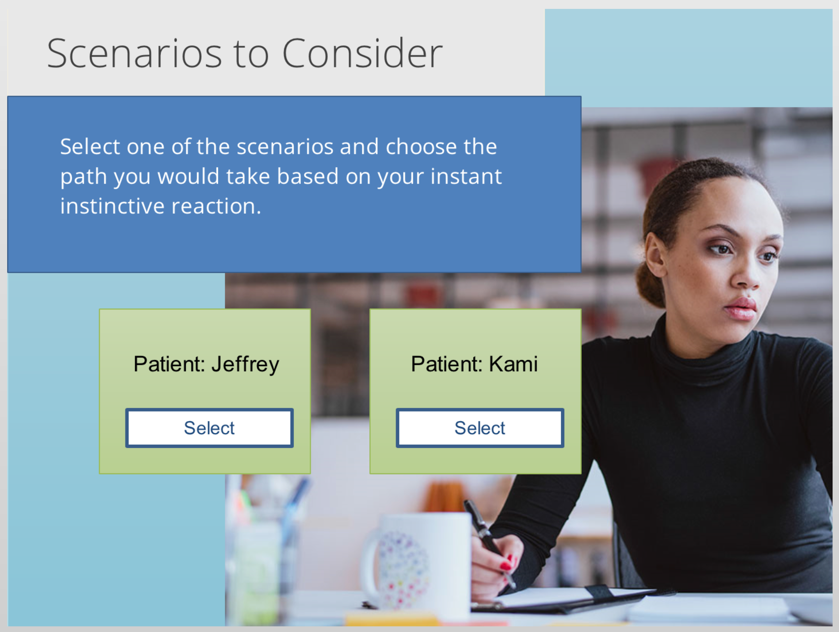Case Study: USF’s Doctor of Nurse Practice Program (DNP) course translates an in-class activity for online learning
The Policy and Ethical Implications for Health Care Outcomes course, developed by Nancy Selix, DNP, FNP-C, CNM, CNL, was redesigned to a hybrid format course from its original format as a face-to-face (F2F) course. Angie Portacio, MA. Ed., instructional designer (ID) for the School of Nursing and Health Professions (SONHP), met with Professor Selix, so they could examine course design options together. In bringing certain facets of the F2F course to online, several gaps were identified during the redesign process.

Instructional Challenge
One instructional challenge was to translate an activity that was held in class and relied upon live student participation and interaction. In the F2F class, Professor Selix stands in front of the class with a stack of index cards. Each card has a written statement of an ethical issue or challenge relevant for healthcare nurses. For example, one card might read, “your best friend's daughter is 16, tells you she's pregnant, and wants to borrow money from you to go to an abortion clinic. If she tells her mother, her mother will kick her out of the house. So what do you do?” Then, students are expected to respond quickly with their initial reaction without question or debate. This activity provokes responses from students based on their own ethical or moral perspective rather than drawn from legal or professional doctrine. The pedagogical challenge was to move this activity into an online environment, and translate it effectively whereby it simulated the spontaneous responses students had had in the classroom.
Developing a Solution
An online, interactive learning activity was conceived of where students were asked to choose from two different possible reactions to a scenario and then were able to see the outcome of their choice. As in the classroom, the interactive piece was a low-stakes activity where the students were not graded on the correctness of their responses. It was a learning activity versus an assessment.

Professor Selix was at first skeptical and did not think the activity could be translated to an online environment. “However,” she continued, “when I worked together with the instructional designers, we were able to come up with technologies that allowed students to click through and you make a choice. And then it says, oh, well if you make that choice, here's what was really going on.”
Students responded positively as well, “in those blue evaluations, students have given me a lot of positive feedback about the course...Almost all of them make comments about the technology and how they liked it and how the course was fresh.
 “Before brainstorming ideas on how to develop an engaging interactive multimedia learning object, we needed to be clear on the expected outcome of the activity and determine the best way to engage students. With the given complexity of the various ethical issues that have different outcomes, we decided we would design and develop a scenario-based interactive learning object.” –Angie Portacio, Instructional Designer
“Before brainstorming ideas on how to develop an engaging interactive multimedia learning object, we needed to be clear on the expected outcome of the activity and determine the best way to engage students. With the given complexity of the various ethical issues that have different outcomes, we decided we would design and develop a scenario-based interactive learning object.” –Angie Portacio, Instructional Designer

In order to address the need to get an instant reaction, students were directed to respond with their first instinct in the instructions at the start of the interactive piece.
Reflections on the Process and Results
On giving a skeptical colleague advice on how to think about converting a F2F activity into an online one, Professor Selix says, “one of the things I would do, first of all, I would say, think outside the box. Number one. If you say, oh, the only way I'm going to do this is just this one way, and I'm not going to change it, then you're not going to get anywhere. So have an open mind, think outside the box, be creative, and allow the input of others to help you. Also consider that your students are almost all digital natives.And so they are very adept at using technology. And so a lot of professors are a little older, myself included. And we have to learn the technology so we can keep up with them and help them learn using the right modalities that fit their generational needs.”
On working with the Instructional Design team: “I thought the team was extremely professional, and met deadlines appropriately, brought things to the table that I didn't have, like the information and knowledge and use of technology. And some of the gaming skills that were brought in, I was not familiar with those. And helping me take what I know from up here and create storyboards for changing that to an online format. And I think we worked extremely well together. It was a pleasure, it was very enjoyable.”